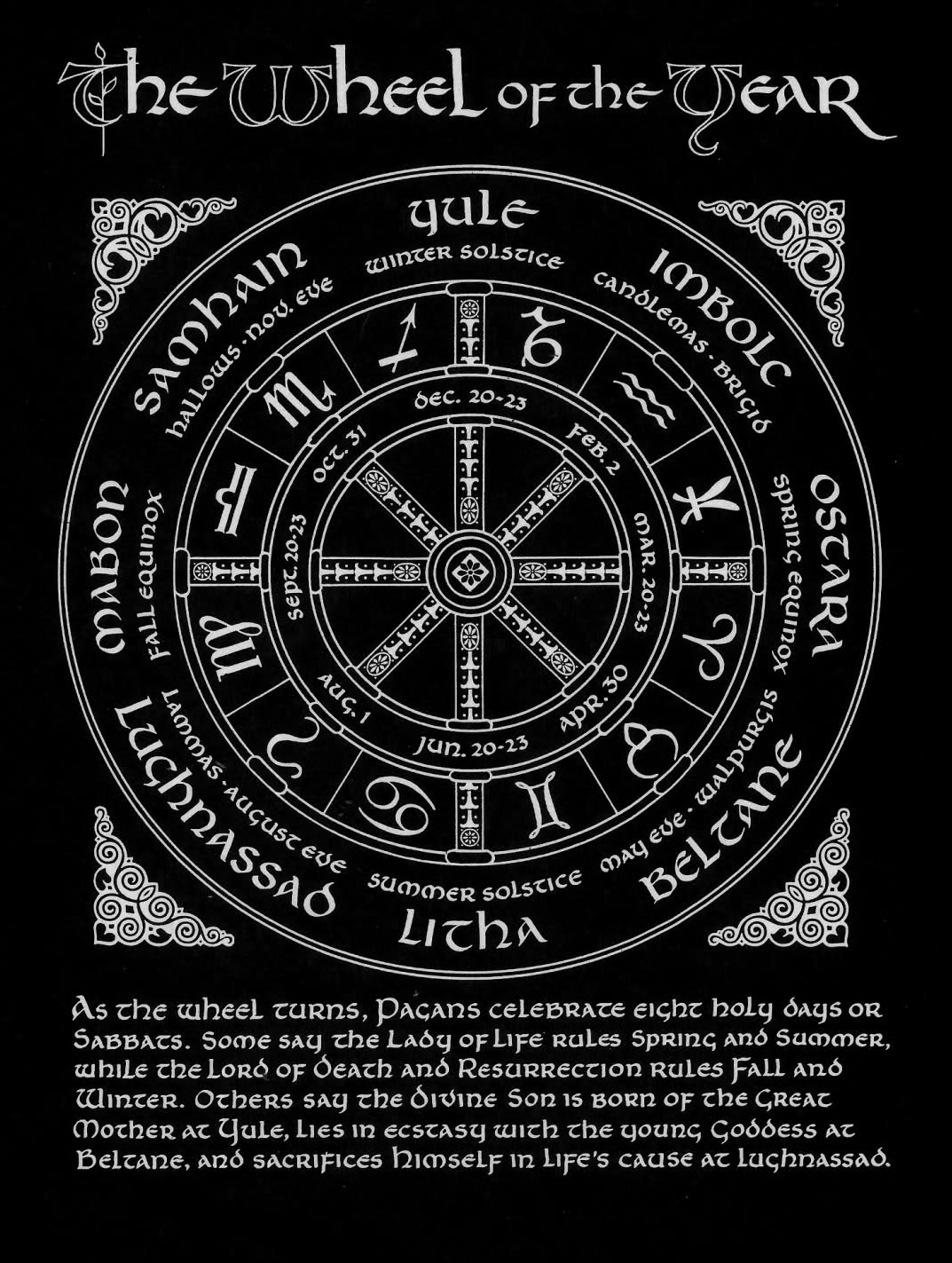chaosophia218: Pagan Wheel of the Year.The Wheel of the Year is celebrated as the Natural Cycle of t
chaosophia218: Pagan Wheel of the Year.The Wheel of the Year is celebrated as the Natural Cycle of the Seasons, commemorated by the eight Sabbats. In Paganism all of Nature is Cyclical, the passing of Time is a Cycle, represented by a Circle or Wheel. The course of Birth, Life, Decline, and Death that we see in our human lives is echoed in the Seasons.The Eight SabbatsThe Eight Sabbats are holidays that celebrate the passing of the year. Each Sabbat also symbolizes a Time in the Life of the Wiccan God, who is born from the Wiccan Goddess, grows to full manhood, mates with her, and reigns as king during the summer. He then declines and dies, rising anew the next year.The dates of the various Pagan Celebrations in the Wheel of the Year change from year-to-year and even differ in the Northern and Southern Hemispheres. The dates given here are for reference and example only. They are provided to assist one in approximating the Time of the year in which the particular Celebration is observed. The Sabbats (Seasons of the Witch) Yule - Winter Solstice (circa December 21) The date varies from December 20 to December 23 depending on the year in the Gregorian calendar. Yule is also known as the Winter Solstice in the Northern Hemisphere and the Summer Solstice in the Southern Hemisphere due to the seasonal differences.Imbolc - Imbolc (February 2) As with all Old Tradition observances, this holiday is usually celebrated beginning at sundown on February 1 and continuing through the day of February 2. Imbolc means in the belly of the Mother because that is where seeds are beginning to stir as it is Spring. Ostara - The Vernal Equinox (circa March 21) As Spring reaches its midpoint, Night and Day stand in perfect Balance, with Light on the increase. The young Sun God now celebrates a Hierogamy (sacred marriage) with the young Maiden Goddess, who conceives. In nine months, she will again become the Great Mother. It is a time of great fertility, new growth, and newborn animals.Beltane - Beltane (May 1)Many Wiccans and Pagans celebrate Beltane. It is one of eight Solar Sabbats. This holiday incorporates traditions from the Gaelic Bealtaine, such as the bonfire, but it bears more relation to the Germanic May Day festival, both in its significance (focusing on fertility) and its Rituals (such as May pole dancing). Some traditions celebrate this holiday on May 1 or May day, whiles others begin their celebration the eve before or April 30th.Litha - Summer Solstice (circa June 21)Although the name Litha is not well attested, it may come from Saxon tradition - the opposite of Yule. On this longest day of the year, light and life are abundant. At mid-summer, the Sun God has reached the moment of his greatest strength. Seated on his greenwood throne, he is also lord of the Forests, and his face is seen in church architecture peering from countless foliate masks.Lughnasadh - Lammas (August 1)It’s time to celebrate the first harvest of the year, and recognize that the hot summer days will soon come to an end. The plants of spring wither and drop seeds to ensure future crops. Grains are ready to be harvested and the fruits are ripe for picking. We can give thanks for the food on our tables.Mabon - Autumn Equinox (circa September 21)The Autumn Equinox divides the day and night equally, and we all take a moment to pay our respects to the impending dark. We also give thanks to the waning sunlight, as we store our harvest of this year’s crops. The Druids call this celebration, Mea'n Fo'mhair, and honor the The Green Man, the God of the Forest, by offering libations to trees. Offerings of ciders, wines, herbs and fertilizer are appropriate at this time. Wiccans celebrate the aging Goddess as she passes from Mother to Crone, and her consort the God as he prepares for death and re-birth.Samhain - Samhain (October 31)Samhain means “End of Summer”, and is the third and final Harvest. At Samhain, the Wicca say farewell to the God even though he readies to be reborn at Yule. This grand Sabbat, also known as Feast of the Dead, Feast of Apples, All Hallows, and of course Halloween, once marked the time of Sacrifice. This was the time when animals were slaughtered to ensure food throughout the winter. The God fell as well to ensure our continuing existence. This is a time of reflection and coming to terms with the one thing in life which we have no control - Death. Wiccans feel that on this night the separation between the Physical and Spiritual realities is it’s least guarded and it’s veil the thinnest. It is a time for dimensional openings and workings, and also the celebration of the Death of the year king. It is a somber holiday, one of dark clothes and thoughts for the dead, it is said to be the time when those of Necromantic talents can speak with the Dead. -- source link
